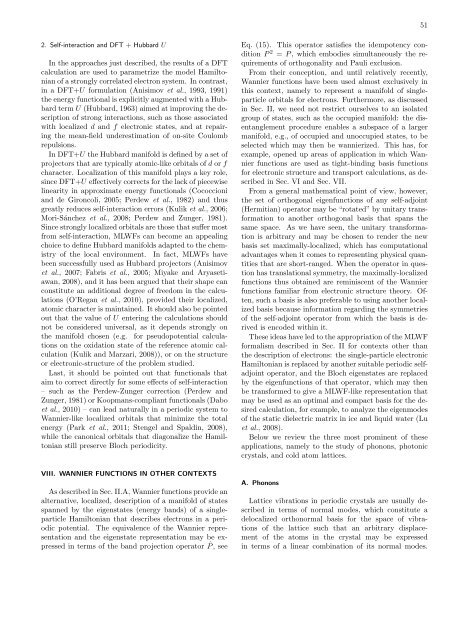Maximally localized Wannier functions: Theory and applications
Maximally localized Wannier functions: Theory and applications
Maximally localized Wannier functions: Theory and applications
Create successful ePaper yourself
Turn your PDF publications into a flip-book with our unique Google optimized e-Paper software.
51<br />
2. Self-interaction <strong>and</strong> DFT + Hubbard U<br />
In the approaches just described, the results of a DFT<br />
calculation are used to parametrize the model Hamiltonian<br />
of a strongly correlated electron system. In contrast,<br />
in a DFT+U formulation (Anisimov et al., 1993, 1991)<br />
the energy functional is explicitly augmented with a Hubbard<br />
term U (Hubbard, 1963) aimed at improving the description<br />
of strong interactions, such as those associated<br />
with <strong>localized</strong> d <strong>and</strong> f electronic states, <strong>and</strong> at repairing<br />
the mean-field underestimation of on-site Coulomb<br />
repulsions.<br />
In DFT+U the Hubbard manifold is defined by a set of<br />
projectors that are typically atomic-like orbitals of d or f<br />
character. Localization of this manifold plays a key role,<br />
since DFT+U effectively corrects for the lack of piecewise<br />
linearity in approximate energy functionals (Cococcioni<br />
<strong>and</strong> de Gironcoli, 2005; Perdew et al., 1982) <strong>and</strong> thus<br />
greatly reduces self-interaction errors (Kulik et al., 2006;<br />
Mori-Sánchez et al., 2008; Perdew <strong>and</strong> Zunger, 1981).<br />
Since strongly <strong>localized</strong> orbitals are those that suffer most<br />
from self-interaction, MLWFs can become an appealing<br />
choice to define Hubbard manifolds adapted to the chemistry<br />
of the local environment. In fact, MLWFs have<br />
been successfully used as Hubbard projectors (Anisimov<br />
et al., 2007; Fabris et al., 2005; Miyake <strong>and</strong> Aryasetiawan,<br />
2008), <strong>and</strong> it has been argued that their shape can<br />
constitute an additional degree of freedom in the calculations<br />
(O’Regan et al., 2010), provided their <strong>localized</strong>,<br />
atomic character is maintained. It should also be pointed<br />
out that the value of U entering the calculations should<br />
not be considered universal, as it depends strongly on<br />
the manifold chosen (e.g. for pseudopotential calculations<br />
on the oxidation state of the reference atomic calculation<br />
(Kulik <strong>and</strong> Marzari, 2008)), or on the structure<br />
or electronic-structure of the problem studied.<br />
Last, it should be pointed out that functionals that<br />
aim to correct directly for some effects of self-interaction<br />
– such as the Perdew-Zunger correction (Perdew <strong>and</strong><br />
Zunger, 1981) or Koopmans-compliant functionals (Dabo<br />
et al., 2010) – can lead naturally in a periodic system to<br />
<strong>Wannier</strong>-like <strong>localized</strong> orbitals that minimize the total<br />
energy (Park et al., 2011; Stengel <strong>and</strong> Spaldin, 2008),<br />
while the canonical orbitals that diagonalize the Hamiltonian<br />
still preserve Bloch periodicity.<br />
VIII. WANNIER FUNCTIONS IN OTHER CONTEXTS<br />
As described in Sec. II.A, <strong>Wannier</strong> <strong>functions</strong> provide an<br />
alternative, <strong>localized</strong>, description of a manifold of states<br />
spanned by the eigenstates (energy b<strong>and</strong>s) of a singleparticle<br />
Hamiltonian that describes electrons in a periodic<br />
potential. The equivalence of the <strong>Wannier</strong> representation<br />
<strong>and</strong> the eigenstate representation may be expressed<br />
in terms of the b<strong>and</strong> projection operator ˆP , see<br />
Eq. (15). This operator satisfies the idempotency condition<br />
P 2 = P , which embodies simultaneously the requirements<br />
of orthogonality <strong>and</strong> Pauli exclusion.<br />
From their conception, <strong>and</strong> until relatively recently,<br />
<strong>Wannier</strong> <strong>functions</strong> have been used almost exclusively in<br />
this context, namely to represent a manifold of singleparticle<br />
orbitals for electrons. Furthermore, as discussed<br />
in Sec. II, we need not restrict ourselves to an isolated<br />
group of states, such as the occupied manifold: the disentanglement<br />
procedure enables a subspace of a larger<br />
manifold, e.g., of occupied <strong>and</strong> unoccupied states, to be<br />
selected which may then be wannierized. This has, for<br />
example, opened up areas of application in which <strong>Wannier</strong><br />
<strong>functions</strong> are used as tight-binding basis <strong>functions</strong><br />
for electronic structure <strong>and</strong> transport calculations, as described<br />
in Sec. VI <strong>and</strong> Sec. VII.<br />
From a general mathematical point of view, however,<br />
the set of orthogonal eigen<strong>functions</strong> of any self-adjoint<br />
(Hermitian) operator may be “rotated” by unitary transformation<br />
to another orthogonal basis that spans the<br />
same space. As we have seen, the unitary transformation<br />
is arbitrary <strong>and</strong> may be chosen to render the new<br />
basis set maximally-<strong>localized</strong>, which has computational<br />
advantages when it comes to representing physical quantities<br />
that are short-ranged. When the operator in question<br />
has translational symmetry, the maximally-<strong>localized</strong><br />
<strong>functions</strong> thus obtained are reminiscent of the <strong>Wannier</strong><br />
<strong>functions</strong> familiar from electronic structure theory. Often,<br />
such a basis is also preferable to using another <strong>localized</strong><br />
basis because information regarding the symmetries<br />
of the self-adjoint operator from which the basis is derived<br />
is encoded within it.<br />
These ideas have led to the appropriation of the MLWF<br />
formalism described in Sec. II for contexts other than<br />
the description of electrons: the single-particle electronic<br />
Hamiltonian is replaced by another suitable periodic selfadjoint<br />
operator, <strong>and</strong> the Bloch eigenstates are replaced<br />
by the eigen<strong>functions</strong> of that operator, which may then<br />
be transformed to give a MLWF-like representation that<br />
may be used as an optimal <strong>and</strong> compact basis for the desired<br />
calculation, for example, to analyze the eigenmodes<br />
of the static dielectric matrix in ice <strong>and</strong> liquid water (Lu<br />
et al., 2008).<br />
Below we review the three most prominent of these<br />
<strong>applications</strong>, namely to the study of phonons, photonic<br />
crystals, <strong>and</strong> cold atom lattices.<br />
A. Phonons<br />
Lattice vibrations in periodic crystals are usually described<br />
in terms of normal modes, which constitute a<br />
de<strong>localized</strong> orthonormal basis for the space of vibrations<br />
of the lattice such that an arbitrary displacement<br />
of the atoms in the crystal may be expressed<br />
in terms of a linear combination of its normal modes.













